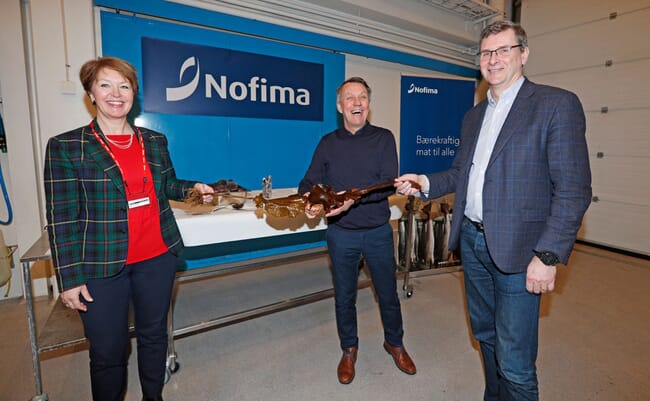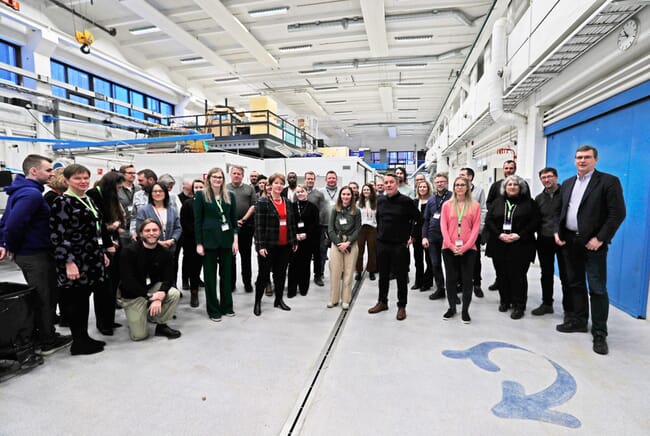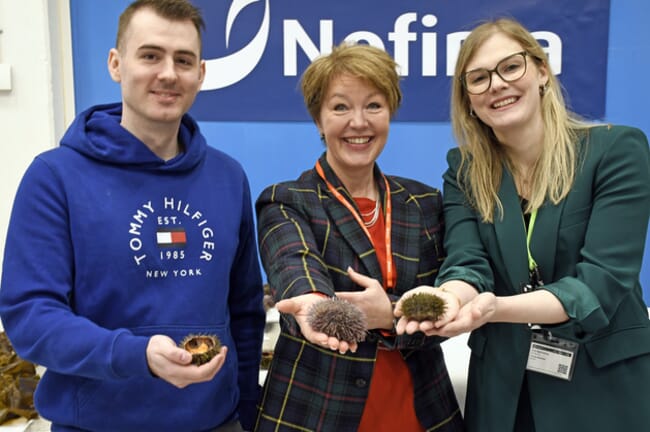
Tromsø’s mayor Gunnar Wilhelmsen cut the kelp during the launch of a network for new farming species at Nofima’s head office in Tromsø, Norway. Left to right: Bente E Torstensen, CEO of Nofima and Harald Sveier, head of research at Lerøy Seafood. © Rune Stoltz Bertinussen, Nofima
Many people think of seafood as mainly fish and shellfish, but seafood is so much more. Sea urchins, shells, seaweed and kelp are all low-trophic species with major potential as food, feed and health products. Many of the species also have lower greenhouse gas emissions than those that are traditionally caught and farmed today.
Nofima CEO Bente Torstensen believes that a national low-trophic network can contribute to increased investment in low-trophic farming in Norway through technology development and knowledge of low-trophic aquaculture. According to a news release from Nofima, the low-trophic species network will be hosted in Tromsø and will have support from the Research Council of Norway.
“The world needs more food and more feed. The number of people on the planet is constantly growing, and with our coastline, Norway can contribute to food production. Low-trophic species are a resource that may become very important in the near future,” she says.
In Norway, there are many players who work with low-trophic aquaculture, but it is only now that they have gathered across species to collaborate on a national network. Plans are being developed in the network for, among other things, sharing experience between industry actors and many of them believe that this industry will have billions in turnover in the coming years.

Low-trophic aquaculture is generating a lot of interest from startups and has the potential to generate billions in turnover in the coming years. © Rune Stoltz Bertinussen, Nofima
The Norwegian Seaweed Association already exists the networks is planning to cooperated with the kelp industry body.
“Low-trophic aquaculture is an industry that is developing at full speed. We are experiencing a lot of interest from startups who want to learn more about the different species. Our goal is to start an annual professional conference in Tromsø that can provide them with new knowledge,” says Nofima senior scientist Petter Olsen.
Together with project partners, the University of Tromsø, NORCE and Bellona, Nofima wants to contribute to the industry gaining access to the latest research, technology and practice.
Nofima already leads Europe’s largest EU project on low-trophic aquaculture, AquaVitae. The research institute is also a key participant in two of the largest EU projects on seaweed and kelp.
“Tromsø is Norway’s largest fishing port and is a seafood city. Traditionally, we think of fish, whether wild or farmed, as seafood. But there is so much more, which is why, as mayor of Tromsø, I welcome this network. I believe that it can create synergies that make this new industry grow quickly,” says Gunnar Wilhelmsen, mayor of Tromsø.
Norway’s aquaculture industry tends to harvest fish at upper levels of the food chain. However, low-trophic aquaculture has lower greenhouse gas emissions and until now – has been underutilised. Several companies are now looking at new species further down the food chain to create new markets.

The three posed with sea urchins at the launch of the national low-trophic network in Tromsø. © Rune Stoltz Bertinussen, Nofima
Using low-trophics as feed
Although low-trophic species are suitable for food, they are also suitable for feed. Today, a lot of imported soy is used in feed for salmon farming. Low-trophic species for feed production can help reduce emissions and make the feed more sustainable. In addition, several of the species contain a high level of Omega-3s, minerals and vitamins, which are good for both fish and people who eat low-trophic species.
Mari Bjordal in Bellona attended the opening and says: “As an environmental organisation, we in Bellona see great potential for the cultivation of species low on the food chain. These species can contribute nutritious food and other bio-resources for which we have an increasing need, while production puts little pressure on the resources that we lack, such as fresh water, fertiliser and land. They can also help us to tackle challenges that we have with excessively high concentrations of nutrients (eutrophication) in certain coastal areas.”
“Many of the low-trophic level species are new farmed species in Norway. The new national network will contribute to the exchange of knowledge and experience and thus will also speed up the development of new, low-trophic species in aquaculture,” she concludes.




